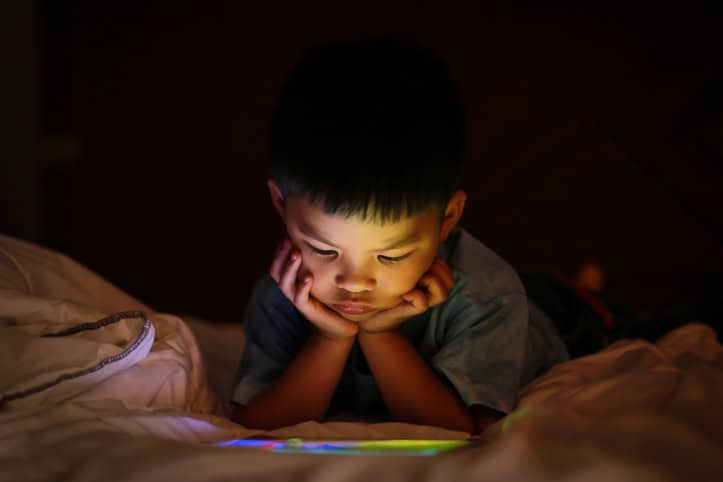Updated guidelines help your family navigate media use
Do you know what the current American Academy of Pediatrics media guidelines are? Don’t be embarrassed if you’re grasping at straws right now; just one in five parents are even aware these guidelines exist!
It’s been nearly 10 years since American Academy of Pediatrics updated guidelines for media use and exposure, and since then, Dr. David Hill of the University of North Carolina School of Medicine explains that there has been a huge shift in both the available forms of media and the understanding of media-use on health outcomes. Dr. Hill begins his review of social media and child health risks by noting that the media environment our children are growing up in is constantly evolving—and health guidance should always evolve too.
Alzein Pediatrics has digested Dr. Hill’s review and recommendations. Here is a summary of the guidance.
0-2 years of age
In some ways, this is the easiest age for managing your child’s media use because they can’t really navigate a device, let alone create social media accounts. It’s also easy because the AAP advice is pretty straightforward: no screen time before the age of 18-24 months, except for Facetiming with family members.
In other ways, this is the hardest stage for parents because it also means thoughtfully and honestly reflecting on your own media habits. A screen cannot replace an active and responsive parent in a child’s development, but screens do prevent parents from being active and responsive in their children’s lives.
Beyond considering the time parents spend looking at screens, new parents should also remember the advice they’ll give their child in the coming years: anything posted online can exist forever. For many parents, this means photos and videos of your child. While it’s easy to be proud of your child, or think friends will enjoy a funny video, think very carefully – and multiple times – about using your kids as content on your social media accounts; over 50% of kids report that their parents have embarrassed them online.
2-5 years of age
Alzein Pediatrics know that the “no screens” rule can’t last long in today’s age, as 98% of all children live in a house with at least one mobile device (smartphone or tablet) and 42% have a device of their own. Now, the AAP guidance shifts from avoiding media to building healthy media habits.
What are healthy habits for preschoolers?
First, set limits. The AAP recommends limiting screen time to one hour a day. Time limits ensure that media use does not crowd out other activities that facilitate better physical and emotional development, like imaginative free play.
Second, curate content. Not all media use is the same. Parents should consider both the quality of the content and the quality of the interaction for their children. Davis recommends Common Sense Media and Sesame Workshop as helpful resources for curating content. Encourages your child to absorb content that engages them in a participatory, rather than passive, experience.
Third, stay in the room. At this age, parents need to co-view and engage with their child during media use. Beyond monitoring the content, parents can help children understand media and create a more active viewer. Ask your child about what’s going on onscreen to spark discussions and learning.
Fourth, stay committed. A media plan is only as good as your ability to follow it, and if you can’t follow it yourself, you’ll have a hard time holding your children to it.
Ages 8-18
Between the ages of 8 and 12, child media use balloons to 6 hours a day on average. One third of that time, 2 hours, is spent on social media. Parents who have followed the AAP guidance are already considering how much and what kind of media their children can use. As their children enter adolescence, parents need to discuss safe and healthy uses of media. The American Academy of Pediatrics recommends families create a plan that will involve older children, teens and parents in setting priorities for media usage. Click here to begin creating your plan.
Research shows that increased communication about social media risks increases parental monitoring and decreases risky health behaviors in children. At the very least, parents need to be talking openly about social media and appropriate online behavior and activity. Ideally, parents should still be co-viewing or monitoring media activity.
Why should we monitor older children?
Monitoring allows parents to track excessive use. While the average child in this age range is on a device 6 hours a day, 11% are on a device more than 8 hours. 8% of all children 8-18 are thought to have an unhealthy relationship to gaming or Internet use that produces addiction-like cycles of irritability, depression, and withdrawal.
Monitoring allows parents to track online behavior. Different kinds of social media users have different experiences. Users who follow and interact online with real-world friends and family report less depression than users who largely follow and interact with strangers. Seeing how your child uses social media can help you teach them how to use it in more constructive ways.
Monitoring allows you to watch out for and discuss the dangers of other uniquely online concerns: cyberbullying which affects 10-40% of children, and sexting which impacts 1 in 10 children over the age of 10.
Davis recommends prioritizing health first by maintaining reasonable limits, including one hour of screen-free time prior to bed to protect sleep. Media, when used appropriately, shouldn’t impact a healthy diet or interfere with frequent physical activity and exercise.
If you’re concerned about your family’s screen time, there are monitoring and time limiting tools that can be implemented which help break the screen habit. You might even consider installing them on your own devices so you can model good media habits and lead by example!


